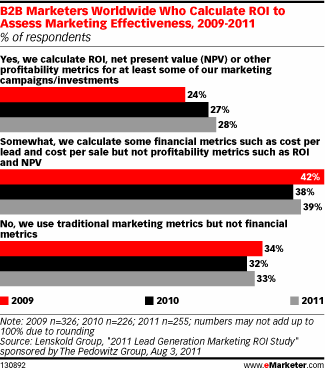Get WISER with Your AI Prompts - A guide for sales managers
Everyone’s wittering on about AI like it’s the second coming. But here’s the rub: if you give it half-baked prompts, you’ll get half-baked answers....
2 min read
 Chris Fell
24/02/2012 9:05:00 AM
Chris Fell
24/02/2012 9:05:00 AM

New data reveals that many B2B marketers are committing a major marketing no-no by failing to measure and report return on marketing investments to senior executives. According to a recent B2B marketing survey conducted by Sagefrog Marketing Group:

So what does this tell us? A third of B2B marketers don't measure their ROI at all, and when they do, they aren't reporting their findings to their bosses. It's no wonder marketers fail so often to get a seat at the boardroom table and the budgets allocated to marketing are so tight, especially for small to medium sized companies. It helps explain why 68% of U.S. B2B companies allocate 5% or less of company revenue on marketing.
Robust ROI measurement and reporting is one of the core components of inbound marketing success. To learn more about inbound marketing, please download our complimentary whitepaper:
How do you measure and report ROI to senior executives? Do you agree that it's an important part in business strategy? Let us know in the comment section below.
Subscribe to our latest news and updates on HubSpot.

Everyone’s wittering on about AI like it’s the second coming. But here’s the rub: if you give it half-baked prompts, you’ll get half-baked answers....

The business world is falling head over heels for AI—and who can blame it? With promises to reduce grunt work, uncover insights, and turbocharge...

Search is evolving - fast. For two decades, SEO has revolved around Google’s algorithm: keywords, backlinks, metadata, and page speed. But with the...